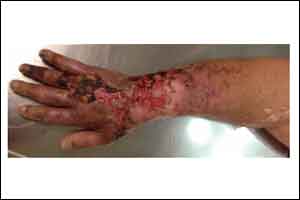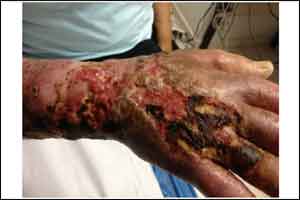- Home
- Editorial
- News
- Practice Guidelines
- Anesthesiology Guidelines
- Cancer Guidelines
- Cardiac Sciences Guidelines
- Critical Care Guidelines
- Dentistry Guidelines
- Dermatology Guidelines
- Diabetes and Endo Guidelines
- Diagnostics Guidelines
- ENT Guidelines
- Featured Practice Guidelines
- Gastroenterology Guidelines
- Geriatrics Guidelines
- Medicine Guidelines
- Nephrology Guidelines
- Neurosciences Guidelines
- Obs and Gynae Guidelines
- Ophthalmology Guidelines
- Orthopaedics Guidelines
- Paediatrics Guidelines
- Psychiatry Guidelines
- Pulmonology Guidelines
- Radiology Guidelines
- Surgery Guidelines
- Urology Guidelines
Dialysis-associated steal syndrome with limb ischaemia

This case of Dialysis-associated steal syndrome with limb ischemia has been published in Journal of BMJ case reports.
A 62-year-old man with end-stage renal failure on dialysis was referred to our hospital with worsening pain and ulceration in his right arm. He has started on hemodialysis 6 months ago, once his newly created brachiocephalic fistula was matured. Previously, he had been on peritoneal dialysis for over 2 years and was transitioned to hemodialysis after multiple catheter-site infections and peritonitis. His medical history was significant for poorly controlled hypertension and hypercholesterolemia.
On physical examination, necrosis of the skin and subcutaneous tissue localized to the right forearm and hand was evident (figure 1), along with dry gangrene of the fourth digit (figure 2). Right radial and ulnar artery pulses were absent. The arm distal to the fistula was cool, with decreased capillary refill and decreased sensation. Continuous handheld Doppler revealed exceptionally low radial and ulnar artery pulse signals and absence of flow at the digital arteries. Compression of the fistula at the anastomosis site was accompanied by pulse return distally and pain relief. Duplex ultrasound examination revealed a patent vascular access with no arterial obstruction. A clinical diagnosis of dialysis-associated steal syndrome was made. To prevent irreversible injury to the affected limb, revision surgery aiming to treat the steal syndrome maintaining the patency of the vascular access was not attempted. In an otherwise potentially infected field, the fistula was urgently ligated and the patient was treated with antibiotics, with the alleviation of the symptoms (figure 3).

Figure 1: Necrosis of the skin and subcutaneous tissue localised to the right forearm and hand.

Figure 2: Ulceration of the right hand along with dry gangrene of the fourth digit.
Decreased arterial blood flow distal to an arteriovenous fistula is a common physiological phenomenon. Most patients are asymptomatic and only a small number of patients experience intermittent pain and numbness during dialysis. On the contrary, patients with severe pain, coldness, pallor or ulceration of the limb and severe ischemia with motor and sensory deficits require further investigation with duplex ultrasonography or arteriography.
Clinical assessment by a vascular surgeon and early radiological or surgical intervention is essential to prevent permanent motor, neurological or tissue damage.
References
- Anderson CB,
- Etheredge EE,
- Harter HR, et al
. Blood flow measurements in arteriovenous dialysis fistulas. Surgery 1977;81:459–61.- Miles AM
. Upper limb ischemia after vascular access surgery: differential diagnosis and management. Semin Dial 2000;13:312–5.doi:10.1046/j.1525-139x.2000.00082.x- Leon C,
- Asif A
. Arteriovenous access and hand pain: the distal hypoperfusion ischemic syndrome. Clin J Am Soc Nephrol 2007;2:175–83.doi:10.2215/CJN.02230606

Disclaimer: This site is primarily intended for healthcare professionals. Any content/information on this website does not replace the advice of medical and/or health professionals and should not be construed as medical/diagnostic advice/endorsement or prescription. Use of this site is subject to our terms of use, privacy policy, advertisement policy. © 2020 Minerva Medical Treatment Pvt Ltd